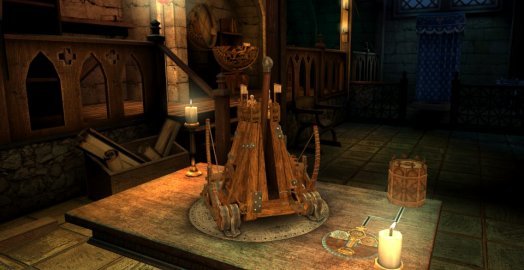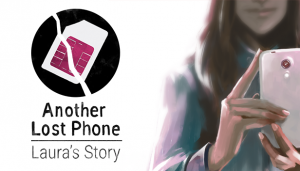Review for The House of Da Vinci

Elaborate creations. Secret societies. Dark corridors and hidden doorways. In a game full to bursting with mysterious nooks and crannies, Blue Brain Games’ The House of Da Vinci will have you twisting, turning, and unlocking a slew of inventions as you attempt to aid your friend and mentor Leonardo, who has found himself in a bit of a pickle. Based solely in and around the renowned Master’s workshop, this gorgeous puzzler has a rather silly storyline, but its Rube Goldberg-esque conundrums will pose a serious challenge, starting out as simple fun before ramping up in intensity (and a bit of tediousness) toward the end.
The setting: Florence, 1506. It’s the height of the Renaissance in Europe, and you can feel the genius and humanist thinking in the air. The deep moan of cellos and other strings float around you, a bit ominous sounding, as you first meet up with a guard under the inky indigo night sky. Warm and wavering firelight flickers in the foreground. It’d feel cozy, if not for the tinge of tension as wind whistles down the streets and a horse whinnies in the distance.
But you’ve got no time to ponder foreshadowing. You’ve been invited by Leonardo da Vinci to check out an amazing new invention. Alarmingly, however, he’s not around to show it to you. The machine promises to change history, and da Vinci has concealed it from those who would steal it for nefarious purposes. Knowing that you have a keen intellect, to help you discover the way into his workshop and eventually the ultimate hiding place, Leonardo has hidden another ingenious invention within an intricate contraption that you must decipher to open.
The initial puzzle isn’t that tricky, but once you find the secret inside, the Oculi Infinitum, you will need it to solve more puzzles throughout the game. This particular device allows you to see things with X-ray vision. Many locked contraptions have a secret code embedded within or must be aligned in a particular way to be unlocked. Rather than just randomly turning knobs and dials when you encounter such a problem, the lens allows you to see through to its inner workings once manually activated.
I played this game on an iPad mini, so to turn those knobs and dials I used my finger to swipe and swirl. You can also swipe the screen to look around, tap to take any collectible objects, and double-tap to examine certain areas closer up. Unfortunately, some of the tap and swipe interactions can be very, very finicky. Sometimes an object would rotate when I wanted it to slide forward, or slide forward when I wanted it to rotate. Because so many obstacles require physical interaction, the frustrating controls decreased my enjoyment a bit. I knew that I could push some lever or twist some screw, but I had to perform the operation just so to get it to work. Also, don’t forget to swipe from multiple directions, as that was the source of some of my frustrations in trying to manipulate objects.
On PC the controls are similar, with clicking and dragging the mouse standing in for swipes and swirls. It’s functional, but doesn’t feel particularly intuitive, and can also be quite fussy. What’s worse is that the default camera panning option may feel inverted for some. There’s an option to change this in the settings, but it doesn’t apply to close-ups, meaning you’ll have to constantly adjust to two different methods. Hotspots aren’t indicated in either version, requiring some guesswork as to what elements might be interactive.
Sticky controls aside, just as you’ve collected da Vinci’s ocular aid, an explosion rocks the scene and a winged contraption swoops high overhead, a dark silhouette soaring past the phosphorescent green blast. The cinematics in this game are quite beautiful and serve to frame each chapter, providing a rickety narrative structure. In addition to these chapter bookends, many of the objects, doors, astrolabes, furniture, suits of armor, and what have you show off dramatic animations as hinges swing open, hidden caches slide forward, and more. And the sound work vividly complements the animations. Metallic gears crunch and grind as you swivel a steering wheel, a brass thunk rings out as a clapper slaps the side of a bell, and the whisper of wood sliding on wood greets you as you pull open a drawer.
Progress though The House of Da Vinci has an overall linear structure, but gives you some flexibility within a given chapter. You must complete one room before moving on to the next, but you can sometimes choose which puzzles within that room to complete, though some puzzles will hold the key or answer to others. You’ll have to find all manner of keys in a variety of shapes and sizes. Sometimes you’ll discover only pieces of these keys and have to seek out more, and sometimes the keys aren’t fully realized when you locate them. After selecting them from your inventory, you’ll have to tap, prod and rotate these objects, sometimes even finding hidden prongs or compartments, to get them into their final usable shape. When you can do this isn’t always clear, so if you're not sure how to proceed, it may be that you're holding onto an item that can be used somewhere but not in its current form.
Once you’ve made it inside da Vinci’s elaborate abode, you’ll discover jewel-colored light filtering through stained glass windows, stately libraries with ornate marble floors, and carved busts of bearded men from times past. And what’s this? You’ve received a new letter from Leonardo! Seems he has another secret invention to help guide you, the Oculi Tempus. This particular lens allows you to see echoes of the past. If you encounter something you can use it on, swipe open the ocular icon and you’ll see a ghostly image showing you how the object in question was used previously. You may be shown just the right number of turns needed or the position required to move something in order to solve your next lock or puzzle.
Though Leonardo himself notes that “the one tool that best allows people to understand the world is the accuracy, consistency, and precision of their observation,” it can be difficult to know when you should use his special lenses from pure observation alone. The many environments to be explored, from the outer street with overturned vegetable carts to a courtyard filled with deathly statuary to an observation room filled with impressive telescopes and measuring instruments, are so full of things to see that I never knew exactly when to use either device. I found myself just trying both whenever I got stuck to see if there were hidden symbols or trace remains I was missing. Gameplay would have been smoother if there were something in the rooms that better indicated there were clues invisible to the naked eye. I much preferred the satisfaction of examining an item and actually figuring out how to open it based on the organic clues provided, such as checking wood for signs of wear like scratches to let me know that some covering could be moved.
If randomly using Leonardo’s Oculi isn’t enough to get you going again, there is a hint button set to a timer, which provides a series of layered tips after short waits. When clicked, it will point you in the right direction, but it won’t let you skip puzzles – which I occasionally found frustrating, especially for the many tile and slider challenges. In fact, I had to restart a chapter just to begin a particularly annoying tile puzzle afresh as there was no way to reset after I already knew I had moved in a wrong tile-flipping direction. And some puzzles have a timing element, where you’ll need to align rotating items at just the right moment, which is really just an exercise in frustration that pulled me out of the world entirely. One puzzle that had me flipping rune tiles and rotating dials was so utterly unintuitive that I honestly had no idea what was happening. Even the walkthrough I consulted noted that you’ll have to wait for sheer chance to complete it. I just dialed and swiped and dialed and swiped, and somehow it worked in the end.
Thankfully, The House of Da Vinci has many other types of challenges that allowed me to get past that annoyance, a few of them making clever use of the game’s namesake. The developers have woven in numerous nods to Leonardo’s actual work, like his wooden tank, the flying contraption seen at the beginning of the game, and even his famous Battle of Anghiari painting reimagined as a puzzle.
There are also minigames and environmental obstacles to keep the experience fresh and full of variety, such as a map strategy game that has you conquering different areas by figuring out patterns and moving pieces across the map. Another task requires figuring out how to use a cannon and then aim it just to escape from a room. For many puzzles I had to take notes, making little drawings of moon phases or jotting down terms and symbols to remember. I even had to look up what a tasset is (armor designed to protect your thighs – who knew?). Entertaining and educational!
As fun as much of the puzzling is, this isn’t just some pleasure stroll through a cryptic genius’s house. Many of the cutscenes hint at a menacing conspiracy, with shadowy figures trailing you as you try to unravel da Vinci’s mysteries, but they somewhat belie the rather sedate atmosphere in which you actually attempt to solve these puzzles. Outside of those cinematics, no one is actually banging at the door trying to find you, and you seem to have all the time in the world. As I moved from opening one elaborately locked room to another, I kept asking myself: if I’m being pursued, why don’t I lock or at least shut the doors behind me? Then again, they’re hilariously complicated locks so this could have been a fatal mistake that my character was smartly avoiding.
Even with such a flimsy premise, the The House of Da Vinci’s gorgeous animations, convincing sound work, and engaging puzzles had me captivated for nearly six hours of gameplay, and I had fun most of that time. I loved the satisfaction of investigating insanely complicated machinery and figuring out how to make it work, even if the actual mechanics didn’t always cooperate. Less rewarding was the reliance on things I couldn’t naturally see, though the Oculi lenses do add an extra layer of puzzling. For those who have played any of The Room games, you’ll be quite at home in Leonardo's rooms, as that series was clearly a strong influence here. If you can look past some wonky controls, the odd obnoxious slider and tile puzzle, and don't ask too much from a story to hold your puzzles together, you’ll enjoy attempting to match wits with one of the greatest thinkers in history.
Our Verdict:
Although The House of Da Vinci is slightly marred by persnickety mechanics and the occasionally frustrating puzzle, exploring the mind of a genius by reverse engineering his inventions will pull you into a gorgeous Renaissance world and keep you challenged throughout.




























